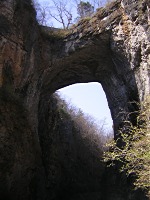As a Virginian by accident of birth, rather than lineage (as my parents’ families were from the surrounding states of North Carolina and Pennsylvania), and as one raised in the “cradle of the Revolution” in the vicinity of Jamestown, Williamsburg, and Yorktown, I have conflicting impulses about historical sites in Virginia. The former impulse says that I should seek out those sites to understand the state in which I was born. The latter impulse says that I should shun the sites and their accompanying flood of hucksterism, sweaty tourists, and admission fees that have inexplicably kept pace with movie ticket prices.
So it is perhaps understandable that—until yesterday—I had never visited the Natural Bridge. Never mind that it was surveyed by George Washington and once owned by Thomas Jefferson, my initial-sake and revered father of The University. Just the fact that I saw billboards for it was enough to put me off. But, yesterday, as I drove down Interstate 81 through the Shenandoah Valley, halfway to my parents’ house, and talking to myself to keep alert, I realized three things:
- The site of the Natural Bridge was less than five miles off I-81, and the road it was on ran alongside the interstate—so I would lose no distance and little time getting to and from the site.
- I was driving by myself down that road and had a little flexibility in my schedule, and who knows when that might happen again.
- I had to use the restroom.
So I pulled off and drove up the road. I was amused to see that the first sign of the Bridge (apart from billboards) was a paddock of deer, grazing in the Natural Bridge Zoo—next to a sign for the Natural Bridge Wax Museum, and just prior to the Natural Bridge Antique Shop and Tool Museum. After a short drive, I pulled up to the imposing neo-plantation Natural Bridge Admissions and Gift Shop building, and stepped outside—and realized that it had been a while since I had experienced 80° weather.
I went inside, past the gift shop, and paid my $10 and went through the door and down the stairs—all 136 of them—to the gatehouse at the bottom of the hill, where the man took my ticket and pointed me around to the right. I stepped through and there, as they say, it was. It’s a massive stone vault or arch that has been carved through by the rather innocuous stream running through the base, and—even with rows of benches permanently installed for the special “Drama of Creation” nightly shows and the sound system mounted on the far side at the top—it’s pretty darned spectacular. My pictures, I’m afraid, do it no justice at all.
Approaching the bridge and looking up, you feel something of the awe inspired by gazing up inside a large cathedral, only this arch was massive and carved over the millennia by water, not craftsmen. The echo under it is pretty spectacular, though I didn’t really test it out too thoroughly.
At any rate, I spent a few minutes walking around and taking pictures—and noting the 19th century names carved in the rock beside the walkway. (Apparently even graffiti was done with an eye to quality then—note the serifs!) Then I began the long climb back up and to the car, avoiding the blandishments of the giftshop (though I was tempted by the custom-label wines from Barboursville, my favorite Virginia winery—and another Thomas Jefferson connection). As I drove back out to the interstate, I realized that I was driving across the top of the bridge—and that the maintainers of the site had built high wooden barriers across the top to keep pedestrians and drivers from getting a free peek.
I highly recommend the bridge as a leg stretcher, provided you can keep a sense of humor about the hucksterism. One does get some of the sense of awe that Jefferson must have felt on discovering the scale of nature’s operations in Virginia, and even gift shops can’t detract from that.

